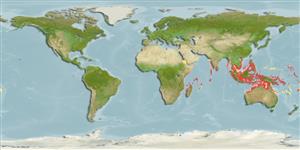>
Ovalentaria/misc (Various families in series Ovalentaria) >
Ambassidae (Asiatic glassfishes)
Etymology: Ambassis: Derived from Greek, anabasis = climbing up (Ref. 45335).
More on author: Bleeker.
Environment: milieu / climate zone / depth range / distribution range
पारिस्थितिकी
समुद्री; स्वच्छ जल, अलवण जल; खारा ड़िमरसल; ऐम्फिढरोमस (Ref. 59012). Tropical; 19°N - 23°S
Asia: Indo-Australian Archipelago, including Indonesia, the Philippines, Borneo, Java, New Guinea, Vanuatu, New Caledonia, to northern Australia and the Andaman Sea. Reported from Palau (Ref. 6371) and the Ryukyu Islands (Ref. 559).
Length at first maturity / आकार / वज़न / Age
Maturity: Lm 7.0 range ? - ? cm
Max length : 12.0 cm TL पुल्लिंग / अलिंग; (Ref. 7050); common length : 5.0 cm SL पुल्लिंग / अलिंग; (Ref. 7242); अधिकतम प्रकाशित वज़न: 12.00 g (Ref. 7242)
पृष्ठीय रीढ़ (सम्पूर्ण): 8; पृष्ठीय सौफट रेज़ (सम्पूर्ण): 9-10; गुदा कांटा 3; ऐनल सौफट रेज़: 9 - 10. Body very high, 50% of SL. Lateral line incomplete, but a few pored scales on a silvery midlateral band. Lower margin of inter operculum with few spines. The second spine of the first dorsal fin is strong and very long.
Found in brackish-water, mangrove, estuarine and freshwater-stream habitats, usually within 20 km of the sea (Ref. 2847). They occur at temperatures ranging from 28 to 32°C. Found in schools and migrate to freshwater. Mainly diurnal. A predominantly marine or estuarine spawner. Caught by hand and scoop nets (Ref. 7242).
A nonobligatory plant spawner.
Allen, G.R., 1991. Field guide to the freshwater fishes of New Guinea. Publication, no. 9. 268 p. Christensen Research Institute, Madang, Papua New Guinea. (Ref. 2847)
IUCN Red List Status (Ref. 130435)
Warning: mysqli::__construct(): (HY000/1040): Too many connections in /var/www/html/includes/func_getlabel.php on line 46
Can't connect to MySQL database (fbapp). Errorcode: Too many connections
